Climbing plant support ideas: how to support them as they grow
Follow our climbing plant support ideas to give your flowers and crops the best chance of flourishing
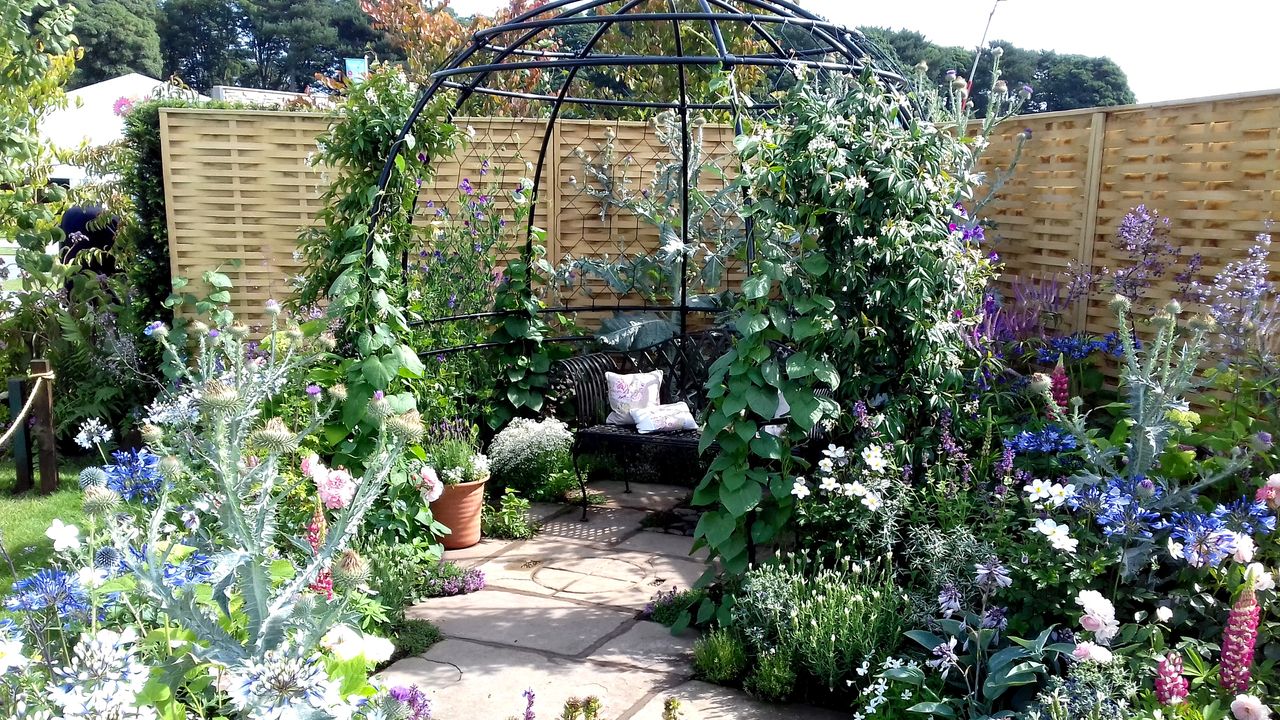

Looking for climbing plant support ideas to give plants like wisteria and roses a helping hand? Climbing plants look stunning in a garden, adding charm and interest to bare walls and fences. Even crops like tomatoes and raspberries can look beautiful thanks to the creeping vines and lush greenery – not to mention that pop of colour when the fruits finally ripen.
Unsurprisingly, though, even the best climbing plants often need a little support as they grow. Providing a structure for them to cling on to will keep them off the ground, making sure they get the nutrients they need and preventing them from going mouldy. You can also use structures to train plants to climb a certain way – over a doorway, say, or framing an arch.
Adding height to your garden can add instant impact and provides an opportunity to include fabulous climbers in your planting scheme, which can be enjoyed looking their best with their heads above the crowd.
Climbing plant support ideas can come in many shapes and sizes, so there's plenty of opportunity to find a suitable design for your style of garden and the type of plants that you want to support. So read on for the best ideas.
Climbing plant support ideas
1. Obelisk

Add height to your flowerbeds with a pretty obelisk
A classic obelisk will add instant charm to your beds and borders. Nestled in the middle of your flowers, it will add height to your planting scheme and create visual impact where you want it most.
Traditional designs are perfect for cottage garden ideas, as their more decorative details will suit the soft, romantic look of billowing flowerbeds. Vigorous annuals such as Morning glory or sweet peas will be lifted above eye level within weeks, giving you a striking focal point to enjoy all summer long.
2. Arch
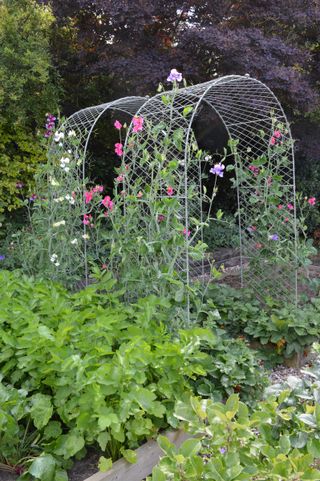
A metal arch from Agriframes creates a striking focal point in this garden
Gardens big and small can benefit from the focal point an archway brings, and as well as adding charm to a space, it's also a great structure for your climbing plant support ideas.
Ideal for roses or clematis, a simple wood or metal design will look bare at first, but with a bit of patience you can create a stunning feature.
'An arch can draw the eye as a focal point or act as a gateway from one area to another, perhaps from a formal to informal area, or from flower to kitchen garden,' say Agriframes. 'You could even consider training fruit trees across the structure.'
3. Pergola
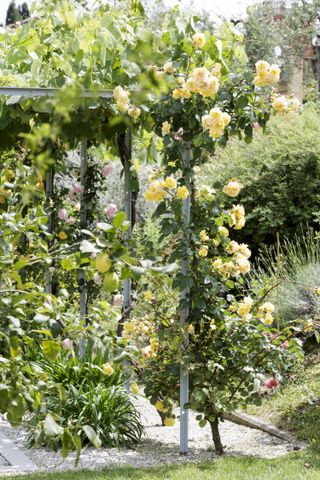
Pergolas have become increasingly popular as a way of creating different zones within a garden. Whether you want to create a shady spot for outdoor dining, a structural centrepiece to break up an uninteresting plot, or just have a quiet spot where you can relax and enjoy the color and scent of your climbing plants, our pergola ideas will do the trick.
'If you are fortunate enough to have space for a longer pergola, spectacular results can be achieved with formally trained wisteria or laburnum whilst a rambling rose such as ‘Wedding Day’ or ‘Rambling Rector’ will reward with an abundance of delicate scented flowers in early summer,' say Agriframes.
4. Screens
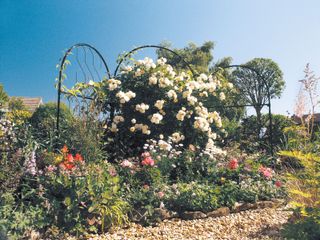
A screen, such as as this design from Agriframes, can be a stylish way to zone your garden
Want to know how to make a small garden look bigger? One of the easiest solutions is to divide your space up into different zones, using screens as a way of breaking up the space. As you aren't able to take in the entire view of the garden in one go, it works to enhance the sense of space.
Training climbing plants to grow up one or more screens can also be a brilliant way to create privacy in your plot, perhaps screening a patio from a neighboring property.
Want to ensure your garden screens have plenty of interest in winter? Go for evergreen climbers such as winter flowering clematis for a beautiful winter backdrop. There's tips on growing winter clematis in our guide.
5. Trellis
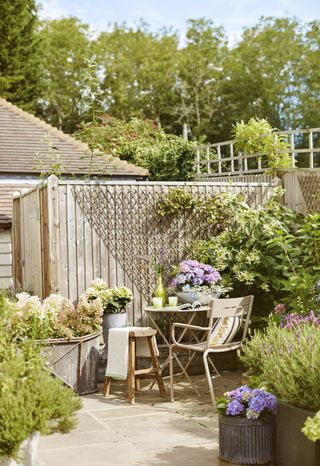
One of the most popular supports, trellises can be placed on a wall or fence and painted to blend in, or stuck in the ground to create a feature in its own right. You can use them to create a living screen of flowers or foliage that will work brilliantly to disguise an ugly wall or fence.
They come in various sizes depending on the type of plant: heavier plants will, of course, need a thicker trellis than species like wisteria.
Wood lattices are the most common, but you can find trellises in a variety of designs to suit your taste and budget.
6. Gazebo
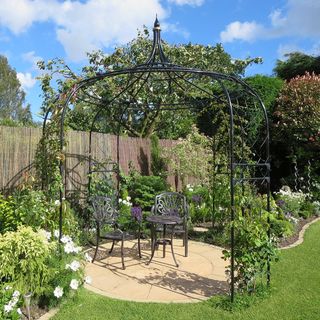
Surround yourself with scented climbers by adding a metal gazebo to your seating area. This Gothic gazebo from Agriframes is available in a wide range of sizes
Designed to provide a shaded place to sit or entertain, gazebos are popular for their structural interest and the opportunities they give for growing beautiful climbers.
'Originally used for vines, popular plants for gazebos now include honeysuckle, roses and jasmine,' say Agriframes. 'The scent can be appreciated by those seated beneath the flowers, and also as it drifts upwards to an open upstairs window. The thornless, highly fragrant Bourbon rose ‘Zephirine Drouhin’ is a great choice for growing over a gazebo if you have children to consider.'
Want to take your gazebo to the next level? Pretty garden lighting ideas, such as twinkling fairy or festoon lights, will create an inviting, romantic vibe for alfresco entertaining after dark.
7. Bower
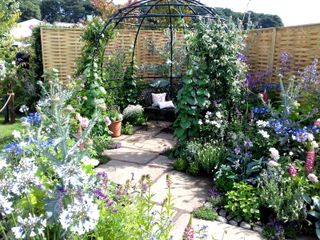
Perfect for creating a secluded spot in your garden, this round bower from Agriframes has plenty of space for a two-or three-seater bench
You might not have considered adding a bower to your garden, but they're perfect for creating a secluded, shaded spot where you can simply sit and enjoy the views of your garden.
Metal garden bowers will add structural interest to a corner of your plot, plus they'll give you endless opportunities for growing some of your favorite climbers.
'A bower tucked into a forgotten or hidden corner of your garden can be swathed in jasmine or roses to create the perfect scented retreat,' say Agriframes.
8. Portico
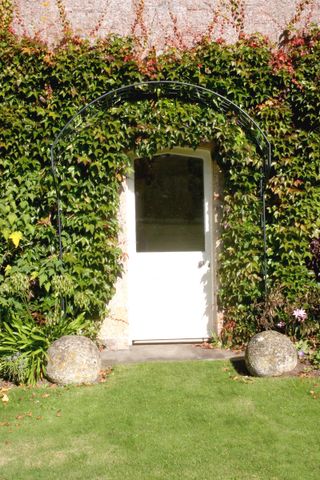
This round portico from Agriframes will allow you to grow plants over your door
A perfect choice for giving your front garden ideas some extra character, adding a portico will allow you to grow climbing plants up and over your front door. What could be a welcome sight when you arrive home that a stunning climbing rose, wisteria or honeysuckle in full bloom?
What's more, using this for your climbing plant support ideas can also help to provide shade in hot weather and shelter you from windy conditions.
9. Kitchen garden supports
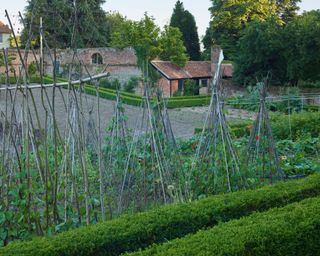
It's not just climbing plants such as roses and clematis that need support, there are plenty of vegetable crops that require a little helping hand too. Varieties such as runner beans, peas, squashes, cucumbers, tomatoes and raspberries will all benefit from the appropriate climbing plant support ideas to help them produce better crops.
There are plenty of designs available to suit your chosen crops too. Choose from metal frames with nets that are perfect for runner beans, hoops to support peas and beans and metal staging for tomatoes.
Head over to our guides on how to grow tomatoes and how to grow runner beans for more growing tips.
10. Planters
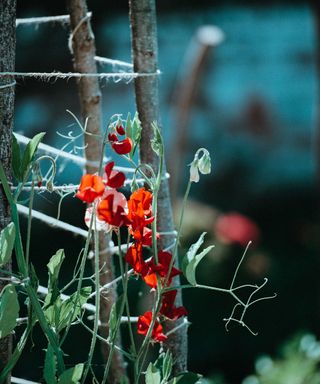
If you're short on space, climbing plants can be grown in pots too. Growing them in this way is great for patio gardening ideas as you can move the pots to where you'll get to enjoy them most, such as next to your seating area.
There's more inspiration for growing plants in pots in our container gardening ideas.
How do you attach climbing plants to supports?
It's best to ensure that you have your climbing plant support ideas in place before you plant your climber. Once planted, tie your climber to the support in several places using garden twine, fanning out the shoots. Don't tie it in too tightly as all you are doing is trying to support and encourage the direction of growth.
As your climbing plants grows, you may need to tie in more shoots to support it further. However, varieties such as sweet peas, clematis and rambling roses will naturally grow up and through the support, wrapping their shoots around the structure to support their own growth.
Do climbing plants need a trellis?
This will depend on the type of plant that you are growing. Some plants such as clematis, climbing roses, jasmine and honeysuckle will typically require the support of a structure, such as a trellis, to aid their growth.
Other plants such as ivy, Virginia creeper, Campsis and climbing hydrangeas are self clinging climbers. They can be a good choice for your garden wall ideas as they will naturally cling to a wall or fence and support themselves in this way, without the additional need of a trellis.

For the past 18 years, Beth has worked for and contributed to a number of leading magazines in the UK, including Real Homes, Ideal Home, Period Living, Grand Designs and Good Homes amongst others. Now the editor of Gardeningetc.com, Beth's attention is firmly outdoors. Her own garden is a really important part of her family's home, and she loves spending time tending to the veg patch or entertaining friends and family at a summer BBQ or alfresco pizza night.
-
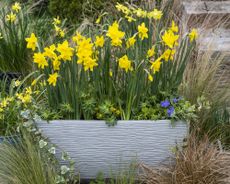 An Update on Gardeningetc
An Update on GardeningetcA word from our publisher
By Beth Murton Published
-
 Do you need to chit potatoes? Find out what the experts say
Do you need to chit potatoes? Find out what the experts sayGrow Your Own Learn how to chit potatoes before planting them in the ground and you’ll be on your way to getting an earlier and bigger harvest
By Drew Swainston Published
